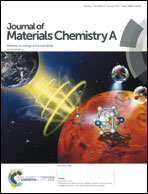Atomically ultrathin RhCo alloy nanosheet aggregates for efficient water electrolysis in broad pH range†
Abstract
To date, noble metal nanostructures are the most efficient and stable electrocatalysts for water splitting. In this study, ultrathin RhCo alloy nanosheet aggregates (RhCo-ANAs) with atomic thickness (1.3 nm) were synthesized by a high-temperature cyanogel-reduction method. Moreover, the electrocatalytic performance of RhCo-ANAs for water splitting was investigated in acidic, neutral, and alkaline solutions. RhCo-ANAs exhibited higher activity and long-term stability for the anodic oxygen evolution reaction (OER) and cathodic hydrogen evolution reaction (HER) than RuO2 nanoparticle (RuO2-NP) and Pt nanoparticle (Pt-NP) electrocatalysts. In particular, RhCo-ANAs only require the overpotential of 31 and 310 mV at the current density of 10 mA cm−2 for the HER and OER in a neutral solution, respectively. Furthermore, we directly grew RhCo-ANAs on carbon foam (CF) (termed as RhCo-ANAs/CF) with flexible property, which could be directly used as a cathode and an anode electrocatalyst for full water splitting in a two-electrode system. The two-electrode electrolyzer, assembled by RhCo-ANAs/CF as a bifunctional electrocatalyst, can provide the stable 10 mA cm−2 current density at 1.54 V potential in a neutral solution. Importantly, the symmetric RhCo-ANAs/CF‖RhCo-ANAs/CF electrolyzer has outstanding reversible switch ability for the HER and OER, which can complete fifty alternating operation by periodically switching the cathode and anode.


 Please wait while we load your content...
Please wait while we load your content...